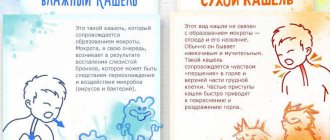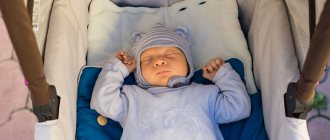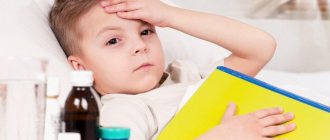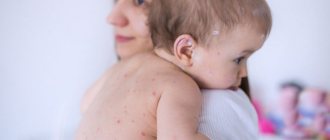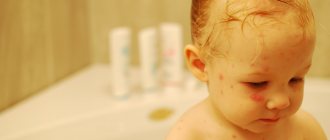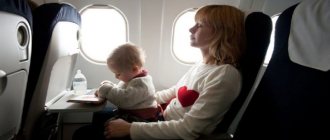Published: October 20, 2018
Daily walks and games in the fresh air are very beneficial for a baby, but is it possible to go for a walk if you have a cold? Some mothers walk with the child even in the acute stage of the disease at elevated temperatures, putting the child in a stroller and wrapping him well. Others do not go outside even a week after all symptoms disappear. What is healthier for a child? Is it possible to go for a walk if you have a cold? Obviously, you need to stick to the golden mean.
Acute period of ARVI: a walk or strict bed rest?
In the acute period of infectious diseases, walking with a cold is definitely not worth it. The baby has a sore throat, a stuffy nose, a high temperature, and general malaise. The child will receive neither benefit nor pleasure from walking in this state, because even changing clothes gives him discomfort. Therefore, it is better not to break bed rest - the small body must save its strength to fight the disease. But it is simply necessary to ventilate the room more often and maintain normal humidity in the apartment in the range of 50–70%.
Allergic and physiological runny nose
In addition to acute rhinitis of an infectious nature, allergic and physiological runny nose is often found.
Allergic rhinitis is characterized by severe nasal discharge. At the same time, sneezing, swelling of the nasal passages may appear, the child’s eyes turn red, and tears begin to flow. The baby becomes restless, sleeps poorly, as it is difficult for him to breathe. The causes of this type of runny nose are dust particles, insect bites, pets, consumption of allergenic foods, exposure to chemicals and cosmetics, use of medications, and home flowers. Allergic rhinitis can occur year-round or seasonally. If you have allergic rhinitis, you should avoid walking where there is a possibility of encountering an allergen. It would also be advisable to use drops that will alleviate the baby’s condition. As you recover, you can gradually increase the time you spend outside.
Physiological rhinitis is a fairly common occurrence, occurring in infants up to three months of age.
Its appearance is a natural process of the newborn’s adaptation to new living conditions outside the mother’s womb. The mucous membrane is not always able to immediately accept and adapt to new living conditions.
The nasal passages are still quite narrow and cannot withstand a defensive reaction. But the child needs to breathe, and the nose needs to perform the basic functions of trapping unnecessary bacteria and dust particles.
We recommend reading: Hardening an infant
The main symptoms of this type of runny nose:
- clear, light discharge from the sinuses;
- the nose is periodically stuffy due to the presence of mucus;
- the baby feels well, is not capricious, eats with appetite;
- sleep remains sound and calm, since with physiological rhinitis there is practically no swelling;
- there are no other signs of an infectious disease - fever, cough;
- When breathing, the baby does not experience any discomfort.
This kind of runny nose does not require treatment; after three months, and often earlier, it goes away without a trace. But it is necessary to alleviate the child’s condition. It will be very useful to moisten the nasal passages using a variety of solutions that contain sea salt. Dried crusts and existing mucus require mandatory removal. This can be done using children's cotton swabs or using an aspirator (but no more than 3-4 times a day).
With this type of runny nose, it is not only possible to walk outside, but it is simply necessary.
Air begins to circulate in the baby’s nasal sinuses, activates the glands, accelerates the formation of nasopharyngeal organs, and stimulates breathing in the newborn
Walking during recovery
How do you know when your child is ready to resume walking? Of course, it is better to consult a doctor! In any case, firstly, the temperature should be normal, that is, below 37.5 degrees. Secondly, the child’s behavior should return to normal and a good mood should return. And even if a runny nose and cough still remain, walking is possible and even necessary for health. If a child does not spend time in the fresh air, diseases of the upper respiratory tract are more difficult to treat. Walking helps to get rid of cough, because this way the airways are more quickly cleared of mucus. This is why a child’s cough can get worse on the street; you shouldn’t be afraid of this, but it can also make it worse.
Theoretical part
The human nose is an ingenious invention of the creator, who bears almost full responsibility for what kind of air enters our lungs, and is therefore “equipped” with a number of interesting systems.
The epithelium inside it consists of different cells. Some of them produce mucus, to which all undesirable elements: dust, microorganisms, etc. “stick” (and at the same time are neutralized, since it has bactericidal properties).
The other part of the cells is represented by numerous microscopic villi, which move in waves and push the secreted secretion to the nasopharynx, from where it safely “falls” into the esophagus and is digested in the stomach.
If any massive attack occurs on the human body, the cells that produce mucus begin to work so actively that the villi are no longer able to cope with it - then a liquid substance flows from the nose, which we call snot.
Conditions for walking
For a healthy child, walks are useful in any weather, but illness imposes significant restrictions. You should not go outside if your child’s temperature has not yet returned to normal and it’s below zero outside. And even at normal temperatures, you shouldn’t start walking if it’s more than -8 degrees outside or it’s very windy.
Walking in sweltering heat - above +35 degrees - will also not bring benefits. In this case, the recovering child needs to either stay in the shade or wait out the heat at home. To avoid overheating, you can go for a walk early in the morning or in the evening before bed.
The right clothes
How to properly dress a recovering child outside so as not to provoke the return of the disease and is it possible to go for a walk if he has a cold?
Mothers quite rightly believe that the main thing after an illness is not to overcool the child, so they often dress him too warmly. While not overheating the child is also very important. A child dressed warmer than necessary for the weather sweats, and then even a light breeze can lead to hypothermia.
You need to dress your child according to the weather, preferably in clothes made from natural fabrics. And in case it suddenly gets colder, you can take a warmer jacket with you. During your walk, regularly check your child's collar and if it becomes wet, then it's time to return home and wear something lighter. You can touch the nose and hands - they should be warm.
Regular walks are extremely important for the physical and mental development of the baby. Children who spend a lot of time outdoors sleep and eat better, get sick less often and develop faster. But don’t worry if, due to ARVI, you are forced to temporarily give them up. When the acute phase of the disease has passed, resume walks gradually, choose suitable places for them, and pay attention to the child’s clothing. By increasing the time of walks by 10–15 minutes a day, within a week you will return to your usual daily routine, and your baby will be able to fully enjoy them.
Swimming with a runny nose
If a runny nose is the only symptom that appears, nothing prevents parents from bathing their child. But before starting the procedure, it is worth taking your temperature. If this indicator does not exceed 37 degrees, then there are no restrictions on water procedures.
If all precautions are taken, bathing will be beneficial, even if the runny nose is of a cold nature. If the disease is accompanied by sweating, microbes and toxins are released through the skin.
Therefore, ensuring body cleanliness allows you to reduce the number of pathogenic microflora, which leads to improved well-being.
Exposure to water has a positive effect on the emotional state of the child. So, after bathing, the baby will be able to fall asleep faster. And quality rest is a good cure for many diseases.
How to bathe a child with a runny nose
To prevent bathing from worsening the child’s condition, it is worth ensuring a number of conditions at the same time:
- close windows to reduce the risk of drafts;
- ensure approximately similar temperature conditions in the bathroom and other rooms;
- when bathing, access to warm water is required to the upper parts of the body to reduce temperature differences;
- slightly increase the water temperature compared to normal swimming, preferably about 37-38 degrees;
- no need to wash your hair unless absolutely necessary;
- the entire procedure should not take more than 10 minutes.
Knowing whether it is possible to bathe a child with snot without fever, it is important to ensure optimal conditions after the procedure. The child must be immediately changed into warm clothes and put to bed
Where and how to swim is prohibited
A runny nose in itself is not a limitation to water procedures. But you should avoid taking a bath if the discharge of snot from the nose is accompanied by:
- fever;
- lacrimation;
- breathing disorder.
You should not organize a bath if the baby himself refuses the procedure. At the same time, it is worth taking care of the prompt elimination of all symptoms unfavorable to the child’s health.
Bath as the simplest inhalation
When deciding whether it is possible to bathe a child with a cold without fever, you can use the bath for therapeutic purposes. Thus, a large amount of warm, moist air enters the child's respiratory tract, which creates an action similar to an inhaler. This allows you to reduce swelling of the mucous membranes, as well as strengthen the immune system.
You can enhance the effect by adding sea salt or herbal infusions to the water. In this capacity, it is permissible to use chamomile, string, eucalyptus and other plants. Then the steam will simultaneously have an antiseptic effect, destroying the pathogenic microflora that provokes the symptom.
//www.youtube.com/watch?v=R_Ks9WZsppY
Rules for the procedure
If you plan to use a sea salt bath as an inhaler, you need to carefully select the product. It must not contain aromatic or coloring substances.
And to achieve the effect, you will need to add at least 500 g of salt crystals per bath or in the ratio: 3 tablespoons per 10 liters of liquid.
When adding medicinal plants to the bath, you must first ensure that there is no hypersensitivity to them. After this, you should purchase dried herb shoots or stock them yourself in the summer.
To prepare the decoction, you need to pour 3 tablespoons of herbal mixture into a liter of water. The mixture must be infused for an hour.
After the required period has passed, it is filtered and poured into the bath immediately before bathing. If desired, you can add a few drops of essential oil to the water.
Komarovsky about child health
The opinions of many leading experts boil down to the fact that regular bathing is one of the ways to support and strengthen a child’s immunity. According to the observations of Evgeniy Olegovich Komarovsky, droplets of water entering the nasal passages improve the condition of the mucous membrane. And the main factor ensuring the safety of the procedure is maintaining the child’s optimal body temperature after contact with water.
However, the doctor advises parents to be attentive to the needs of their child
So, it is important to organize the feeding process not according to the clock, but according to the baby’s desire to eat. Putting to bed is required when the child really needs rest
And you shouldn’t send your son or daughter to the bathroom if he doesn’t feel the need for it.
Don't forget to treat your cold
And yet, it is important to remember that ARVI is a disease fraught with relapses and dangerous complications. Treatment of colds in children should be under the supervision of a specialist. Everything that the doctor prescribes and recommends must be used in full, without arbitrarily shortening the duration of therapy, even when it seems that the disease has completely subsided. When treating acute respiratory viral infections, specialists often prescribe Derinat as a complex anti-cold remedy with antiviral and reparative effects, helping to reduce viral activity, strengthen the body's own defenses, and also strengthen the barrier properties of the nasopharyngeal mucosa. The drug is prescribed to children from birth and adults. You can read more about the drug on our website.
Take care of your children's health!
Useful articles:
